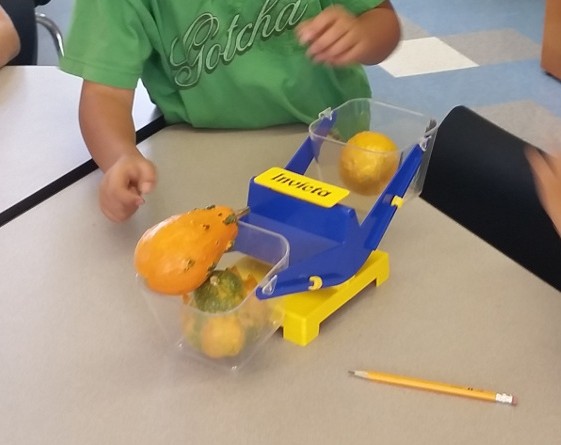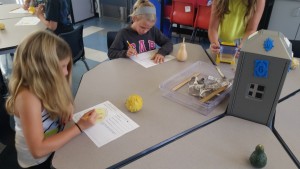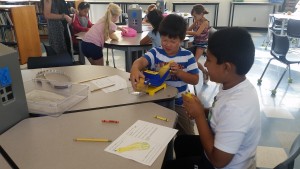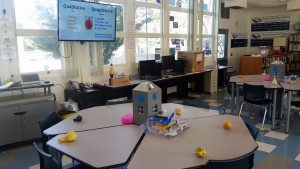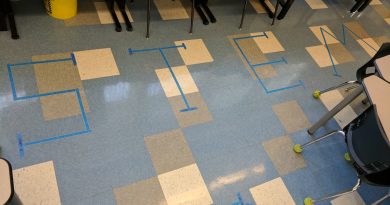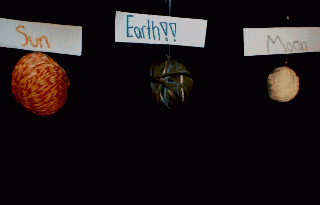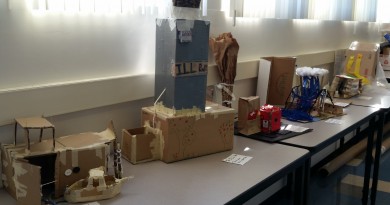Qualitative and Quantitative Gourds
Objective:
Use math and science tools to practice observation
Key Words/concepts:
Qualtitative
Quantitative
Observation
Overview of Lesson:
This is a much more structured lesson than many of my other elementary ones. With this lesson, the students arrived in the STEM Lab to find a gourd at their seat. As a scientific introduction, I did a brief explanation of taxonomy, starting with the examples of cats and lions and ending up with the gourd family. I had the students think of characteristics that were similar between all members of this family based on their experience and many of the grade levels were able to make the connection to growing on vines, the outer rind, and the inner seeds. From there, we did some guided discovery where I introduced the term Qualitative and had the students observe their gourd qualitatively. The students answered in their mind as I led them through them using their senses to observe the gourd. Example questions: “What shape is it?”, “How does the skin feel?”, “How does the stem feel?”, “What colors do you see?”, “How many colors?”, “Does it make any sound when you shake it?”, etc.
Next we moved on to Quantitative, and I targeted my questions to be more about numbers and comparisons. For size questions, I had them compare the gourd to their fist, face, ear, foot, and see if they could fit their hands around it, etc. Weight I had them think if it was heavier or lighter than them, a paper, and a sandwich. The sandwich question was quite thought provoking for the students. I also asked them how old they thought the gourd was, which ended up providing an enormous range of answers. Finally, we brainstormed what other tools we could use to measure the gourds. The older students could name most of the standard tools while the younger ones tended to jump to “inches” or “centimeters” rather than saying “a ruler”.
For their independent observations, I handed out a worksheet where the students had to record their own qualitative and quantitative observations of their own gourd. I learned quickly that the students had to do the qualitative first, or else they would get distracted by the quantitative tools and never get back to the first part. Students first had to draw their gourd, including all the irregular shapes and colors. This was a very good challenge and made it very clear to the teacher which students have an eye for detail and which just drew a yellow circle and nothing else. Students also had to think of adjectives to describe their gourd. For the quantitative side, students had to come up with a number of ways to measure their gourds. They could use the tools on the table, as well as any other measurement systems they could think of. I had them focus more on the comparisons rather than the exact measurements, setting up the sentence frame of “____ than” when making quantitative observations. Students had about 10 minutes to complete this independent investigation. At the end when there was enough time, I had a few students share their adjectives or a few comparison sentences to compare their gourd with others around the room.
Differentiation by age groups:
Different worksheets for grade levels. The K-2 students just had to draw their gourds and then finish four sentences about the size of their gourd. The 3-5 students also had to add their grade level’s worth of adjectives and methods for measuring (i.e. 4th grade needed 4 adjectives, etc).
Materials/Requirements:
–> Gourds: I bought 36 small gourds at Trader Joe’s, choosing ones that were all unique. These gourds lasted for all 16 classes because I really did my best to monitor them and to make sure students were not harming them.
–> Measuring tools- balance scale, cloth tape measures, rulers
–> Drawing tools- pencils, colored pencils, crayons, or markers in gourd colors
Conclusions/Reflections for the future:
This was a very calm and controlled activity to do after the previous cardboard challenge activity. The students were highly engaged and the activity was approachable for students of all ages. The older students did indeed tend to finish earlier, but often I could give them an additional challenge to go back and try. In all grade levels, the highlight was using the balance scales. The students had quite a lot of fun comparing their gourd to their classmates’ gourds and even combined multiple gourds to determine the heaviest at their table. I have found it hardest to deliberately incorporate math into my activities so this was indeed my first attempt at it, knowing that every grade level has had different levels of practice with measuring and reasoning. This activity was inspired by a preschool activity, so I enjoyed the challenge of taking the basic idea and scaling it upward for the upper grades.
Digital Resources:
Idea Sources:
Little Bins for Little Hands: Weighing Measuring Water Science Experiment for Kids
